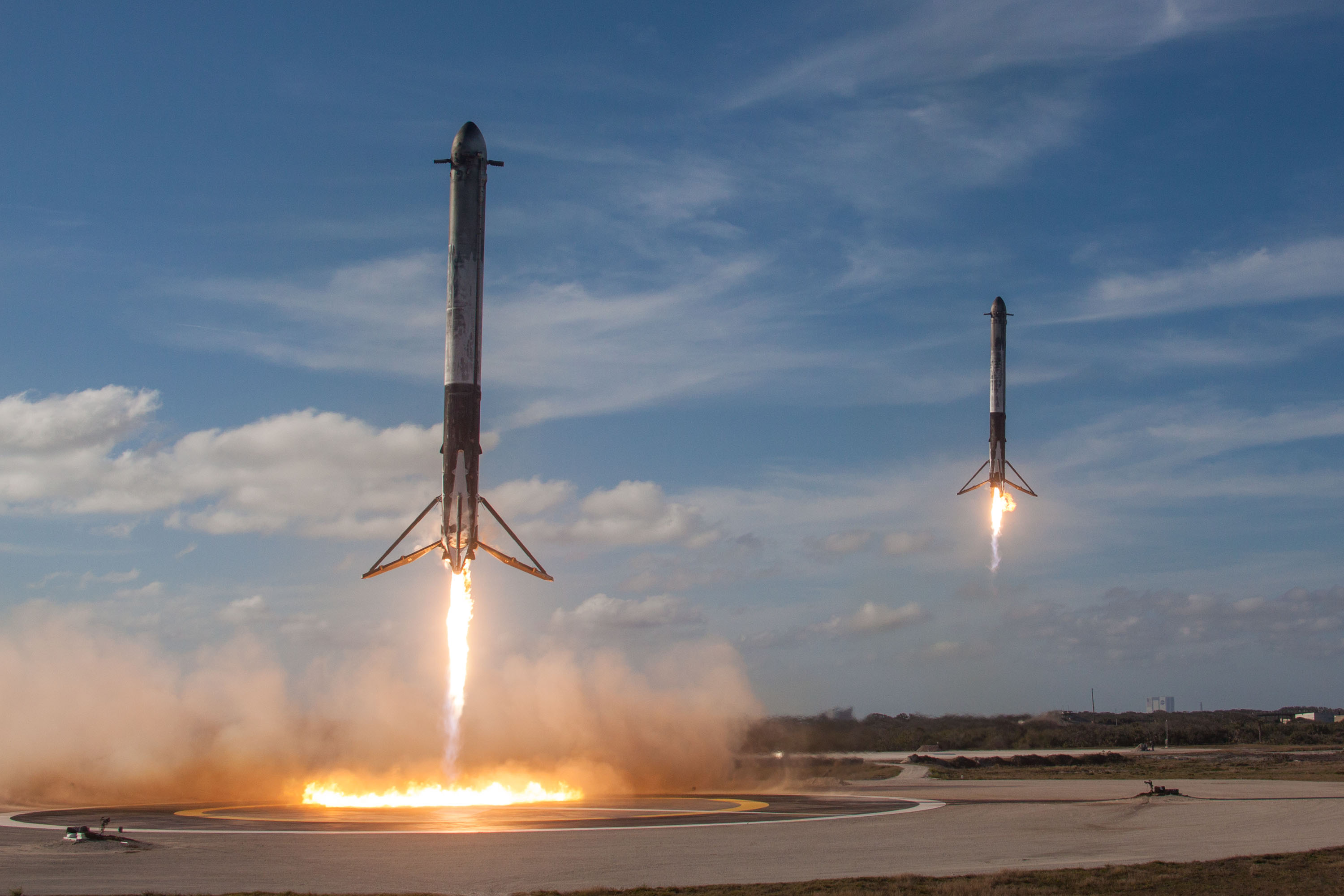
The side boosters of a SpaceX Falcon Heavy rocket return to their landing pads in Florida on Feb. 6, 2018, after the megarocket's maiden flight. SpaceX Flickr photo.
SpaceX captured the world’s attention last week as its massive Falcon Heavy rocket boosted a Tesla Roadster into space. The live feed of Starman, the dummy driving the cherry red electric car through the solar system, got more than 13 million hits on YouTube. Even novice space watchers were fascinated by the rocket’s two side boosters seamlessly returning to Earth, setting down on their landing pad like a perfectly choreographed dance.
But the mission was more than just a genius marketing strategy, the Falcon Heavy could potentially change the way National Security Space payloads are launched in the future. And, if certified, the Falcon Heavy’s reusable boosters could offer significant savings to the Air Force.
Members of the Air Force’s mission assurance team monitored the mega rocket’s first flight from Cape Canaveral AFS, Fla., and the Space and Missile Systems Center in El Segunda, Calif., SMC officials told Air Force Magazine.
The Air Force certified SpaceX’s Falcon 9 rocket, the predecessor to Falcon Heavy, to compete for NSS mission in May 2015, after an exhaustive, and sometimes bumpy two-year certification process. Now SpaceX and the Air Force are working together on Falcon Heavy certification and design validation efforts, USAF officials said.
“Lessons learned and knowledge gained from the Falcon 9 certification process have helped streamline the Falcon Heavy certification process overall,” said James Spellman, an SMC spokesman. “That said, Falcon Heavy is a different launch system than Falcon 9. Accordingly, the Air Force uses a consistent independent verification and validation process for certification and design validation for any EELV [evolved expendable launch vehicle] new entrant launch system.”
The Air Force’s Launch Services New Entrant Certification Guide, published in 2011, provides four certification options, “based on maturity of the launch system,” said Spellman. New entrants may be required to fly anywhere from two to 14 flights, “with fewer flights requiring increased technical evaluation for certification,” said Spellman. Once a new entrant files a statement of intent with SMC, the two sides will then negotiate a formal agreement.
“Certification begins with a technical evaluation and detailed analysis of the launch vehicle design and a review of their manufacturing and system engineering processes,” said Spellman. “In addition, analytical data from the new entrant’s flight history is evaluated to ensure the vehicle performed as expected.”
Falcon Heavy’s successful launch follows the Jan. 7 launch of a secret payload, called Zuma, that mysteriously went astray after launching from a SpaceX Falcon 9 rocket. Because of its classification, details on what went wrong during the Zuma launch are not clear. SpaceX president and chief operating officer Gwynne Shotwell said in a statement last month that after reviewing “all data to date,” the Falcon 9 “did everything correctly.” The Air Force will say only that the mission was not completed as intended.
T?he commander of the Space and Missile Systems Center, which in part manages the military’s space program, told Air Force Magazine it’s routine for SMC to review telemetry data about launches after the fact. And, “based on that data,” Lt. Gen. John Thompson said the team “did not identify any information” calling for a change in Falcon 9’s certification. “The Air Force will continue to evaluate data from all launches,” Thompson added.
Today, space launch can cost anywhere from $90 to $500 million, depending on the vehicle, the payload, and the sought orbit, according to Air Force Space Command. The Air Force touts its continuous struggle to reduce costs by increasing competition in the space launch domain, buying in bulk, and innovating, an AFSPC spokesperson told Air Force Magazine. For example, it’s saved more than $4 billion since a December 2013 block buy agreement on the Evolved Expendable Launch Vehicle program. Since April 2016, the command says it’s saved $90 million by increasing competition for EELVs.
There are 28 launches currently projected for Fiscal 2019. Twenty of those will take off from the more popular Eastern range—from which both the Falcon 9 Zuma mission and the Falcon Heavy took off—while eight will launch from the Western range. AFSPC will run six of them, all planned for the Eastern range’s Cape Canaveral AFS, Fla. Non-AFSPC launches could include those from the Navy, the National Reconnaissance Office, or NASA, to name a few examples. Launch rates fluctuate based on governmental, commercial, and research needs.
In FY18, AFSPC is on course to run four Eastern range launches out of a total of 49 launches comprising both ranges. In FY17, it ran four—again Eastern range—out of 33 total.
Spellman said the second Space Test Program launch on a SpaceX Falcon Heavy is scheduled for later this year. The mission is intended to “demonstrate the Falcon Heavy launch vehicle capability,” while placing 24 separate spacecraft in three different orbits, said Spellman. “After completion of all the deployments, the launch vehicle will conduct a fifth ignition of the second stage engine to demonstrate capability required for geosynchronous insertion type mission.”